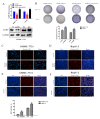HAMP Downregulation Contributes to Aggressive Hepatocellular Carcinoma via Mechanism Mediated by Cyclin4-Dependent Kinase-1/STAT3 Pathway
- PMID: 31052210
- PMCID: PMC6628061
- DOI: 10.3390/diagnostics9020048
HAMP Downregulation Contributes to Aggressive Hepatocellular Carcinoma via Mechanism Mediated by Cyclin4-Dependent Kinase-1/STAT3 Pathway
Abstract
Background: Hepcidin encoded by HAMP is vital to regulating proliferation, metastasis, and migration. Hepcidin is secreted specifically by the liver. This study sought to examine the functional role of hepcidin in hepatocellular carcinoma (HCC).
Methods: Data in the Cancer Genome Atlas database was used to analyze HAMP expression as it relates to HCC prognosis. We then used the 5-ethynyl-20-deoxyuridine (EdU) incorporation assay, transwell assay, and flow cytometric analysis, respectively, to assess proliferation, migration, and the cell cycle. Gene set enrichment analysis (GSEA) was used to find pathways affected by HAMP.
Results: HAMP expression was lower in hepatocellular carcinoma samples compared with adjacent normal tissue controls. Low HAMP expression was linked with a higher rate of metastasis and poor disease-free status. Downregulation of HAMP induced SMMC-7721 and HepG-2 cell proliferation and promoted their migration. HAMP could affect the cell cycle pathway and Western blotting, confirming that reduced HAMP levels activated cyclin-dependent kinase-1/stat 3 pathway.
Conclusion: Our findings indicate that HAMP functions as a tumor suppressor gene. The role of HAMP in cellular proliferation and metastasis is related to cell cycle checkpoints. HAMP could be considered as a diagnostic biomarker and targeted therapy in HCC.
Keywords: HAMP; cell cycle; hepatocellular carcinoma; iron; metastasis.
Conflict of interest statement
The authors declare no conflict of interests.
Figures






Similar articles
-
Hepcidin and DNA promoter methylation in hepatocellular carcinoma.Eur J Clin Invest. 2018 Feb;48(2):e12870. doi: 10.1111/eci.12870. Epub 2017 Dec 28. Eur J Clin Invest. 2018. PMID: 29235098
-
MCM6 promotes metastasis of hepatocellular carcinoma via MEK/ERK pathway and serves as a novel serum biomarker for early recurrence.J Exp Clin Cancer Res. 2018 Jan 22;37(1):10. doi: 10.1186/s13046-017-0669-z. J Exp Clin Cancer Res. 2018. PMID: 29357919 Free PMC article.
-
Metallothionein 1H (MT1H) functions as a tumor suppressor in hepatocellular carcinoma through regulating Wnt/β-catenin signaling pathway.BMC Cancer. 2017 Feb 28;17(1):161. doi: 10.1186/s12885-017-3139-2. BMC Cancer. 2017. PMID: 28241806 Free PMC article.
-
Downregulation of CLDN7 due to promoter hypermethylation is associated with human clear cell renal cell carcinoma progression and poor prognosis.J Exp Clin Cancer Res. 2018 Nov 14;37(1):276. doi: 10.1186/s13046-018-0924-y. J Exp Clin Cancer Res. 2018. PMID: 30428910 Free PMC article.
-
SWELL1 promotes cell growth and metastasis of hepatocellular carcinoma in vitro and in vivo.EBioMedicine. 2019 Oct;48:100-116. doi: 10.1016/j.ebiom.2019.09.007. Epub 2019 Oct 6. EBioMedicine. 2019. PMID: 31597595 Free PMC article.
Cited by
-
Identification of novel biomarkers in septic cardiomyopathy via integrated bioinformatics analysis and experimental validation.Front Genet. 2022 Jul 25;13:929293. doi: 10.3389/fgene.2022.929293. eCollection 2022. Front Genet. 2022. PMID: 35957694 Free PMC article.
-
Biological roles and molecular mechanism of circular RNAs in epithelial-mesenchymal transition of gastrointestinal malignancies.Oncol Res. 2025 Feb 28;33(3):549-566. doi: 10.32604/or.2024.051589. eCollection 2025. Oncol Res. 2025. PMID: 40109856 Free PMC article. Review.
-
High Hepcidin expression predicts poor prognosis in patients with clear cell renal cell carcinoma.Diagn Pathol. 2022 Dec 31;17(1):100. doi: 10.1186/s13000-022-01274-9. Diagn Pathol. 2022. PMID: 36585741 Free PMC article.
-
The Role of Iron in Cancer Progression.Front Oncol. 2021 Nov 10;11:778492. doi: 10.3389/fonc.2021.778492. eCollection 2021. Front Oncol. 2021. PMID: 34858857 Free PMC article. Review.
-
Mechanism of iron on the intestinal epithelium development in suckling piglets.Sci China Life Sci. 2023 Sep;66(9):2070-2085. doi: 10.1007/s11427-022-2307-7. Epub 2023 May 18. Sci China Life Sci. 2023. PMID: 37233872
References
Grants and funding
LinkOut - more resources
Full Text Sources
Miscellaneous

